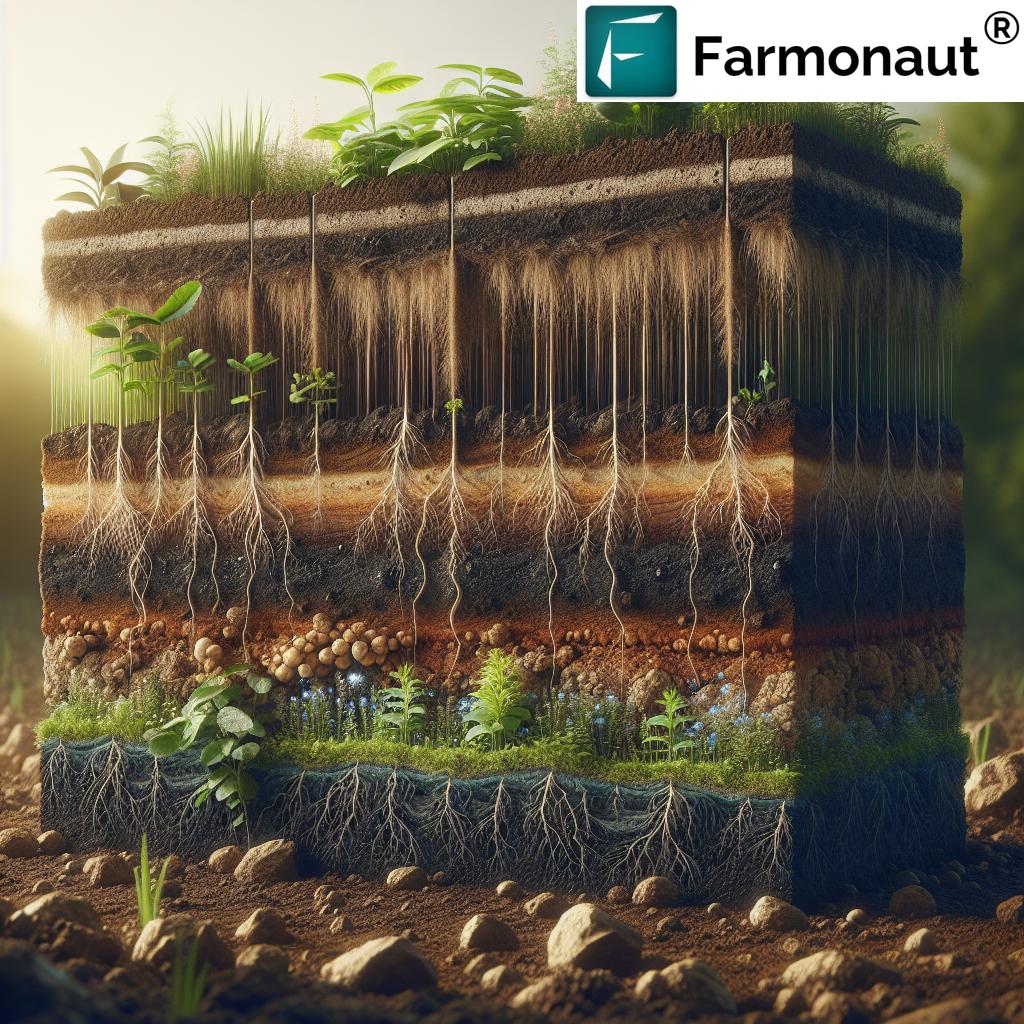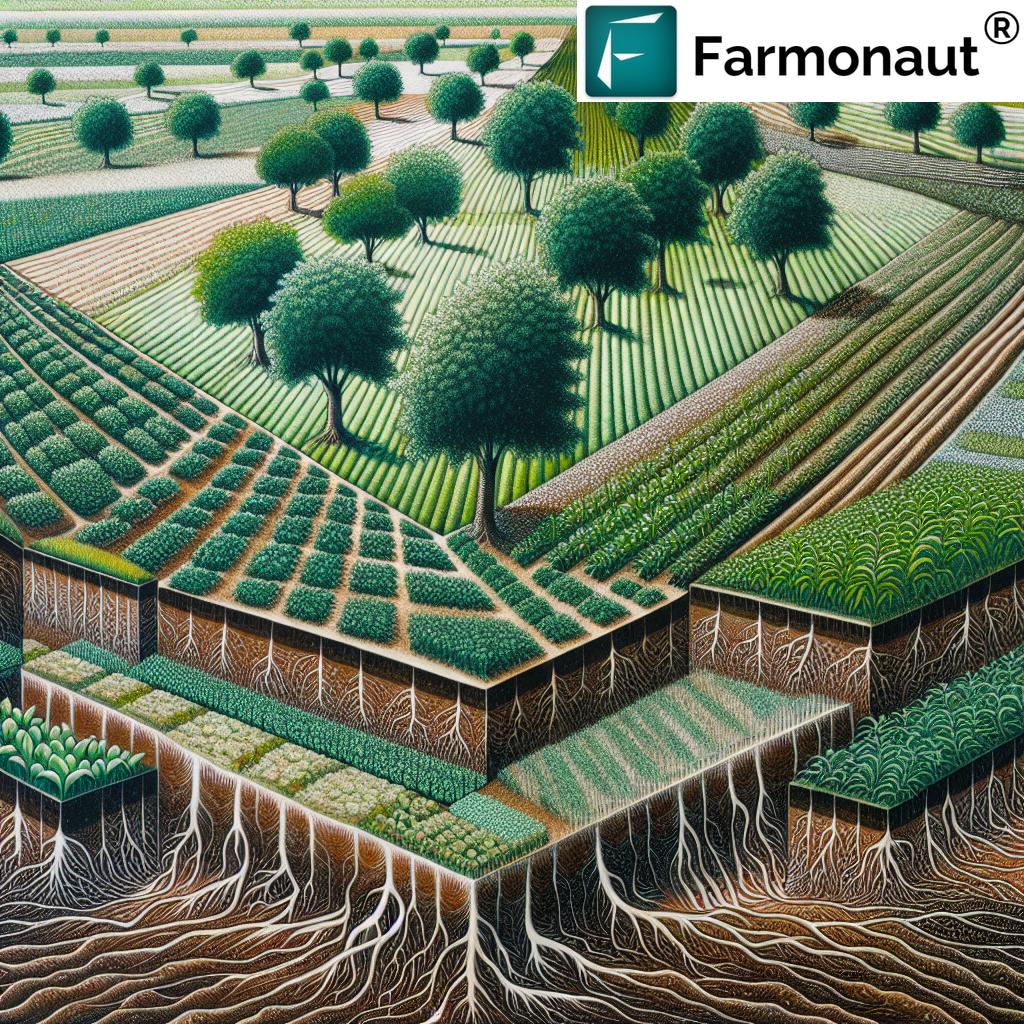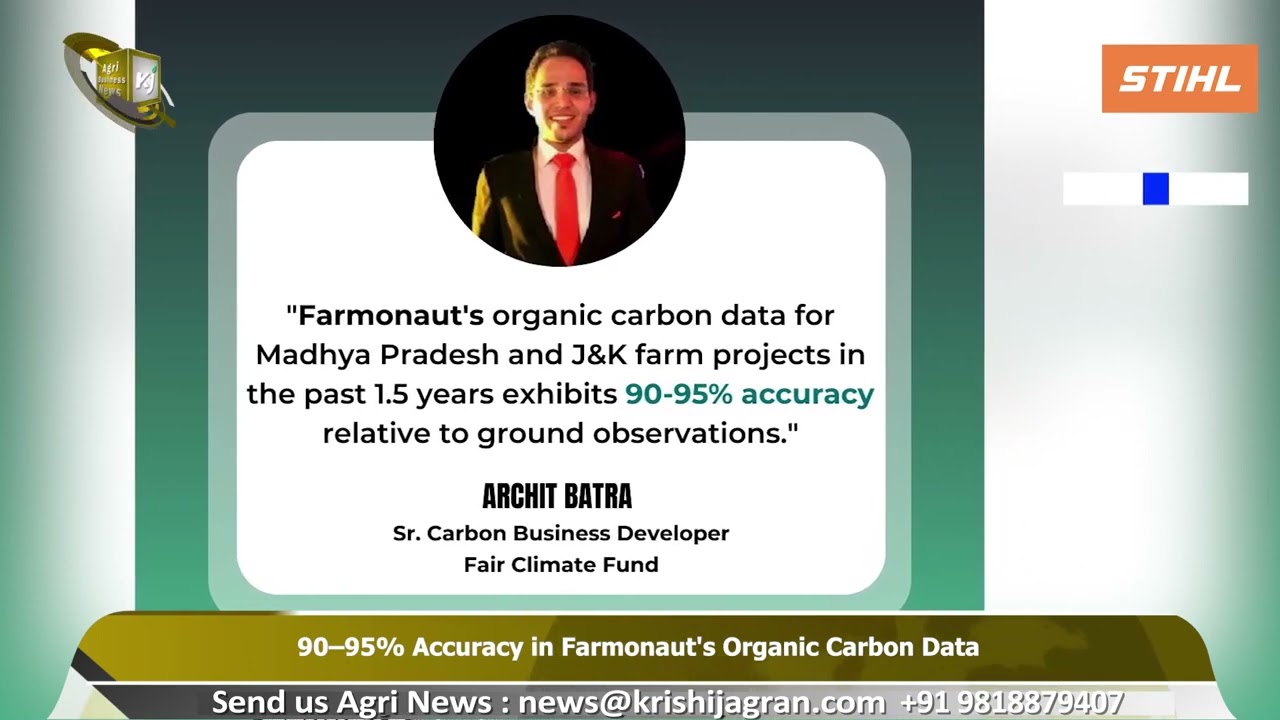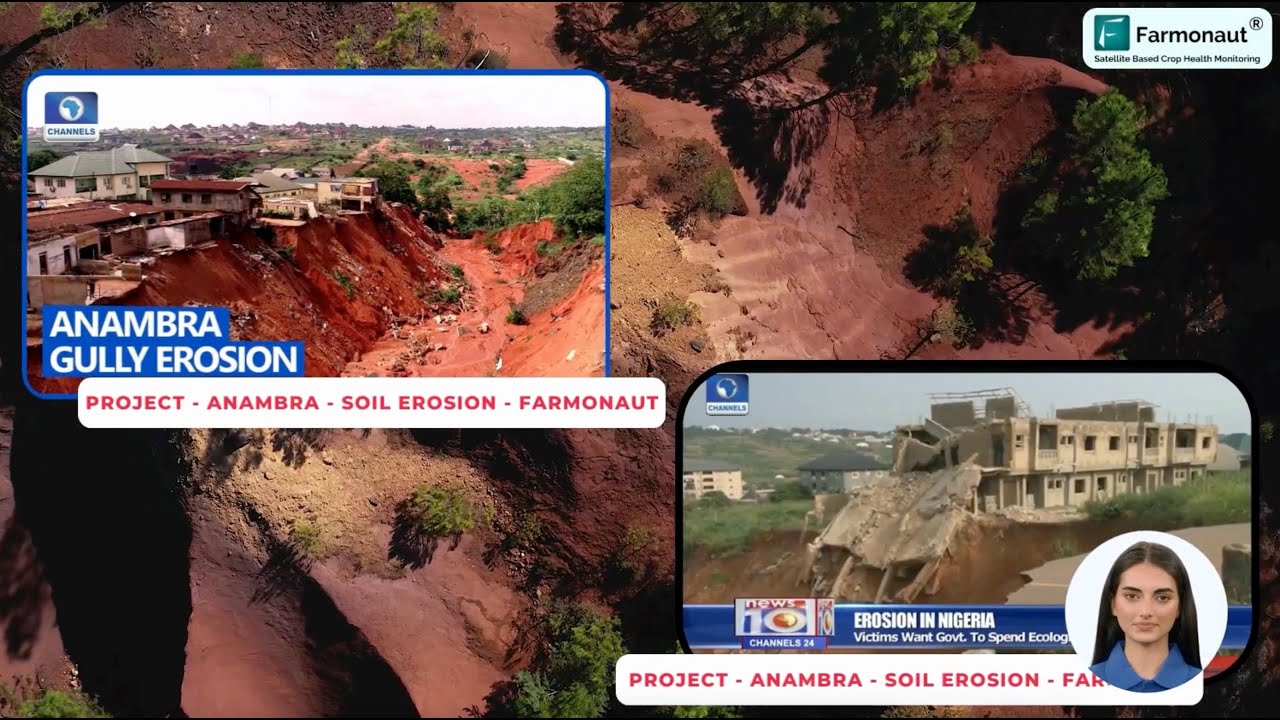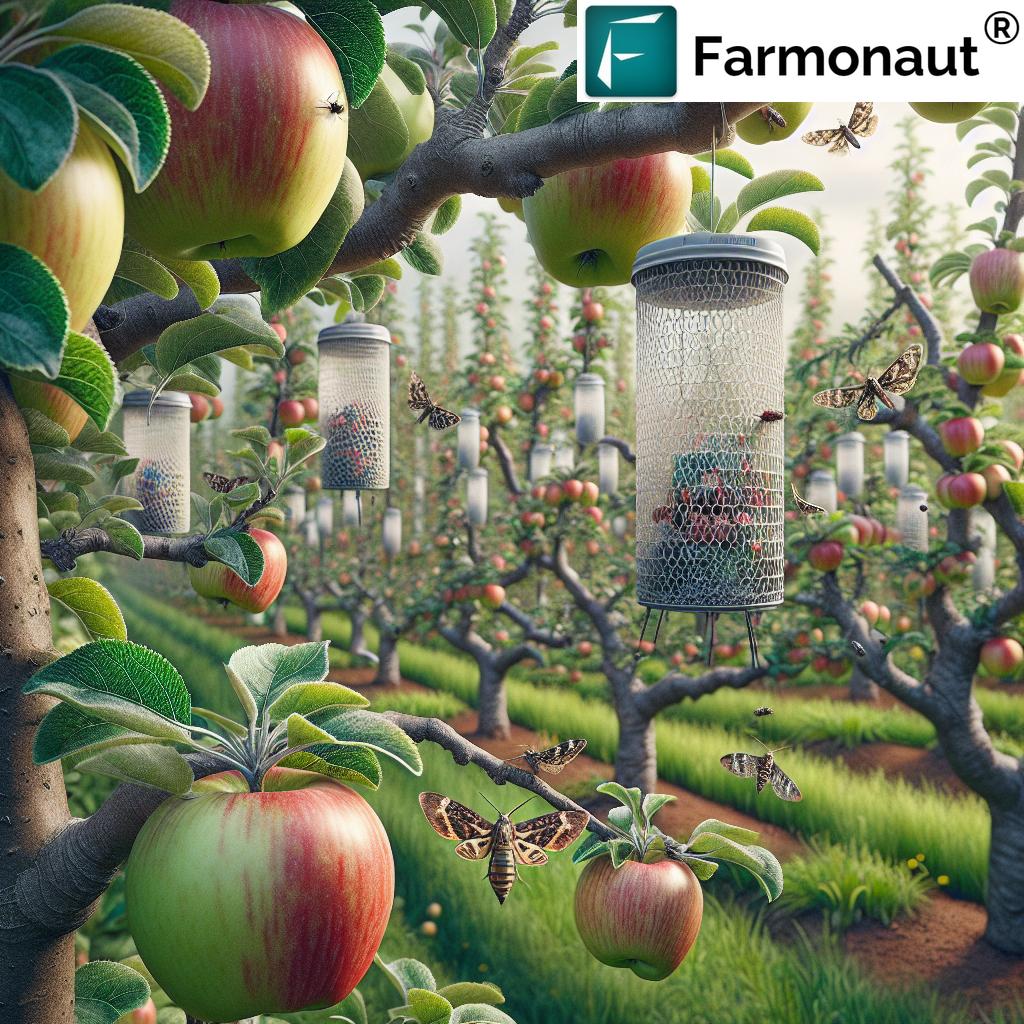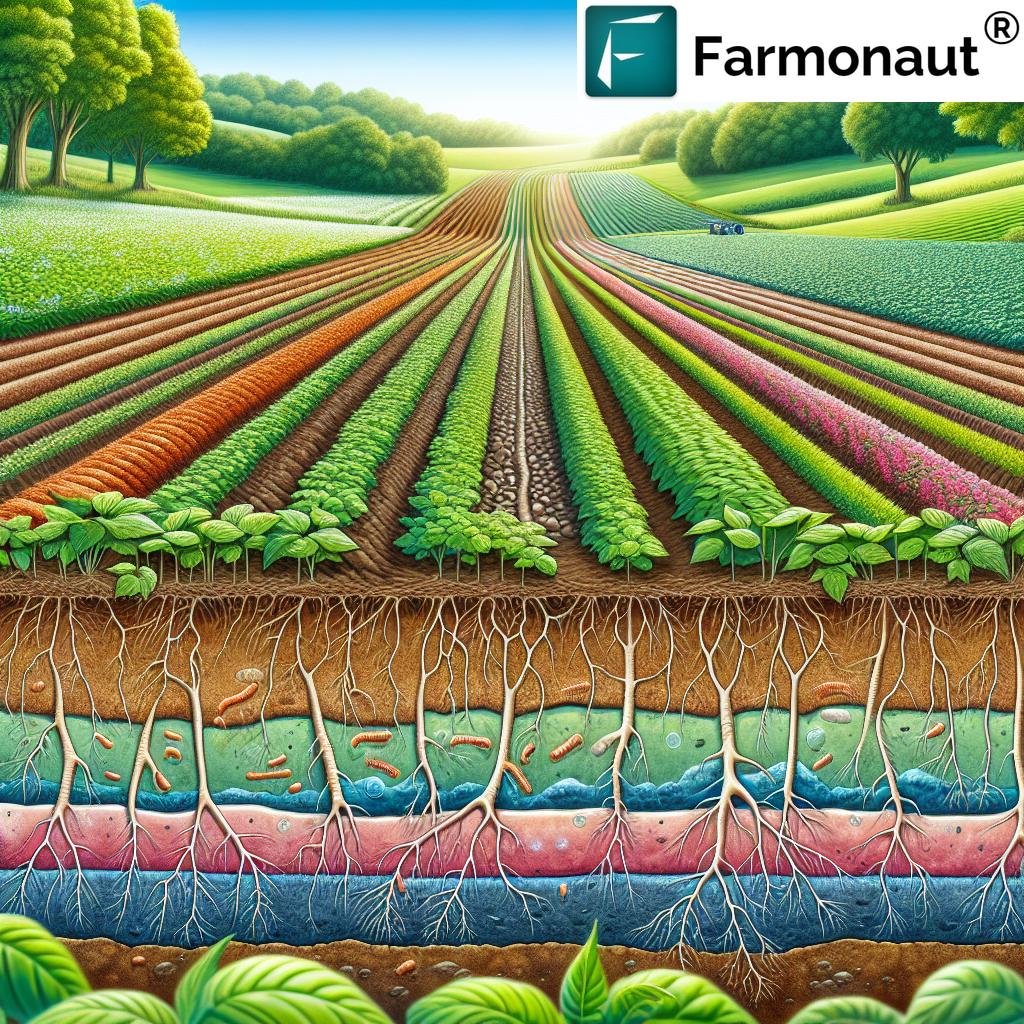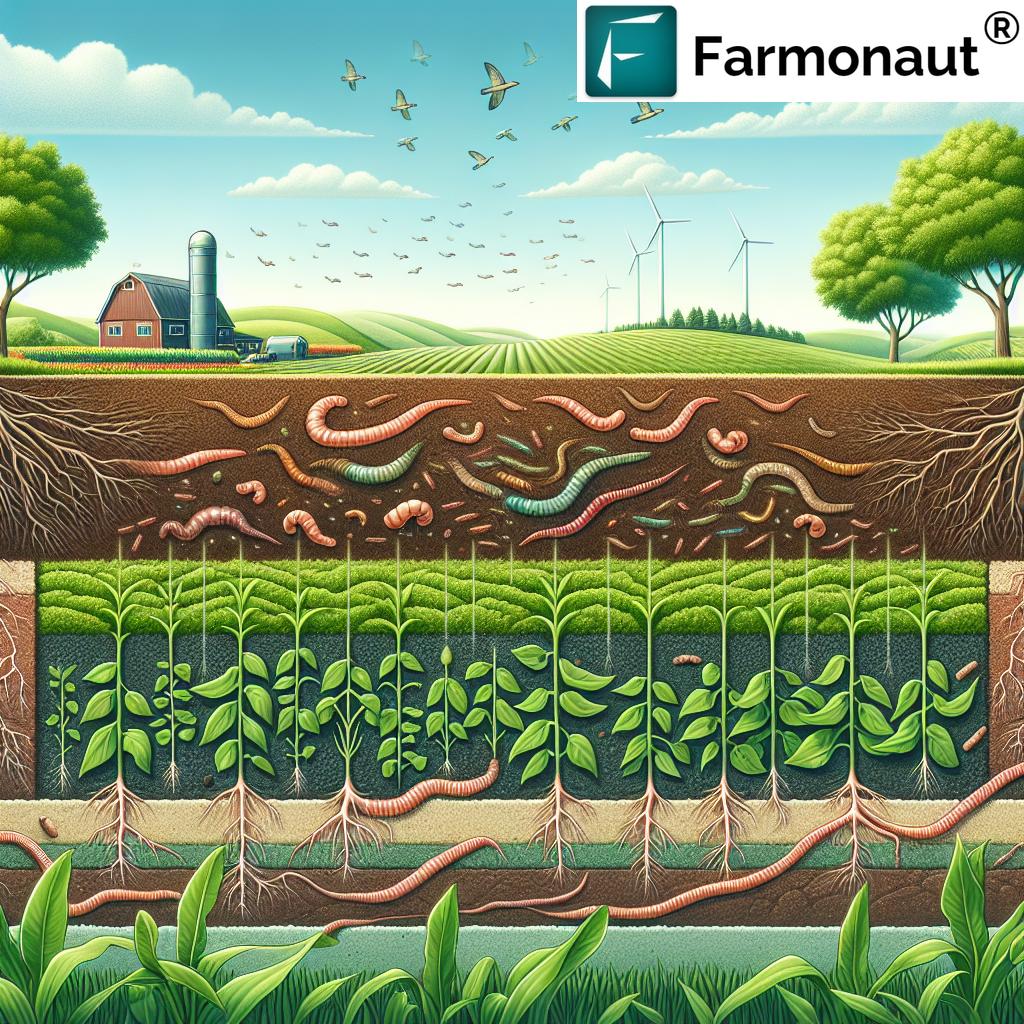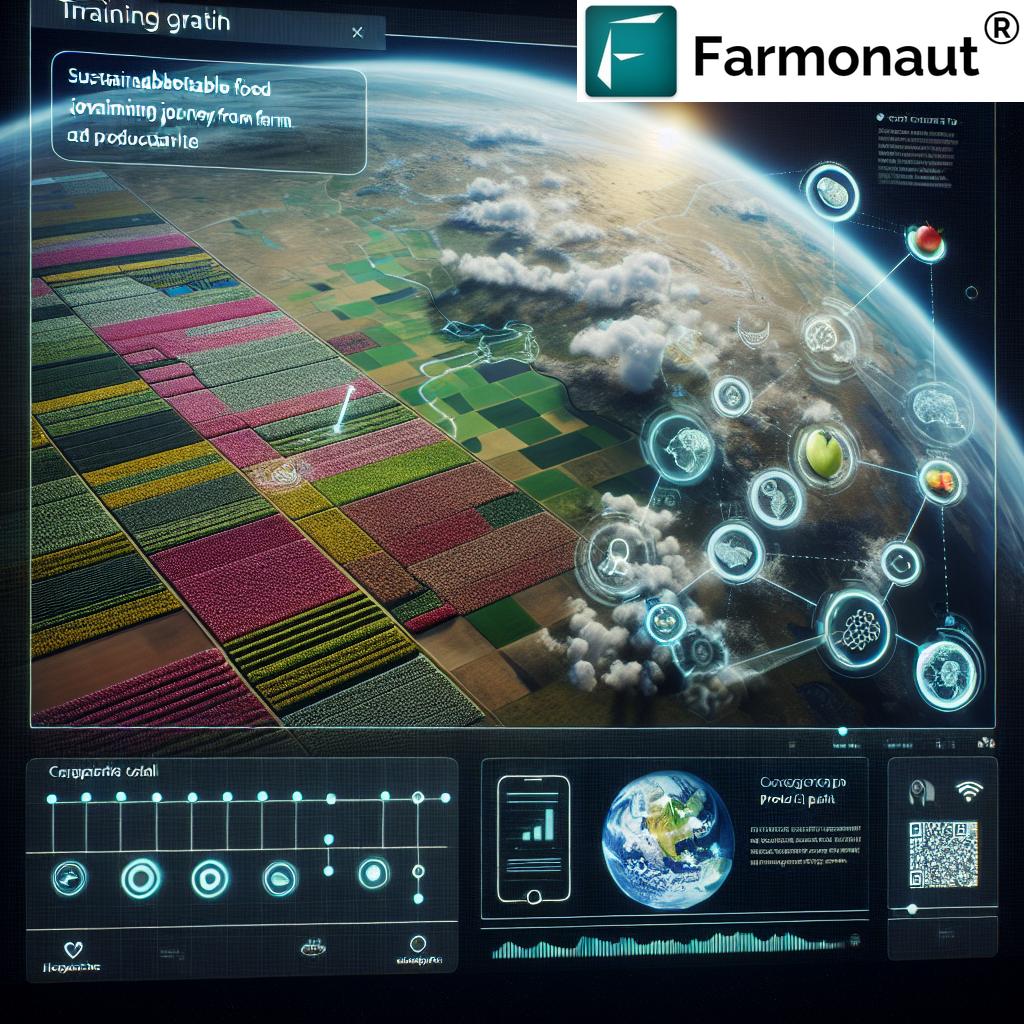What is Soil Organic Carbon? 7 Powerful Ways to Boost Levels
Meta Description: Soil organic carbon is the cornerstone of soil fertility and structure, crucial for carbon sequestration and sustainable management practices. Discover its formation, benefits, and 7 impactful strategies to elevate SOC levels!
Table of Contents
- Introduction to Soil Organic Carbon
- How is Soil Organic Carbon Formed?
- Soil Organic Carbon Composition: POC and MAOC
- The Role of Soil Organic Carbon in Agriculture, Forestry, and Climate
- Key Factors Influencing SOC Levels
- 7 Powerful Ways to Boost Soil Organic Carbon Levels
- Comparison Table: Practices to Increase Soil Organic Carbon
- Why Enhancing Soil Organic Carbon Matters
- Leverage Farmonaut for Sustainable Soil Management
- Challenges and Considerations in SOC Management
- Frequently Asked Questions (FAQ)
- Conclusion
Introduction to Soil Organic Carbon
Soil organic carbon (SOC) is the lifeblood of our soils—a fundamental component of soil organic matter (SOM) that acts as a pivotal player in the global carbon cycle. As the largest terrestrial carbon pool, SOC represents the bulk of carbon atoms in land-based systems, influencing not only soil fertility and structure but also the broader environmental processes that sustain life on Earth.
SOC is not just an academic topic—understanding and promoting it is at the core of sustainable soil management, climate change mitigation, and soil carbon sequestration. In this comprehensive guide, we explain what SOC is, describe its genesis and impact, and detail the seven most effective, research-backed practices to enhance soil organic carbon levels for fertile, resilient soils.
What Exactly Is Soil Organic Carbon?
Soil organic carbon is the carbon stored in soil as part of decomposed plant, animal, and microbial residues. This mixture of organic compounds, called soil organic matter (SOM), is mostly carbon atoms bound within organic molecules. SOC originates from both aboveground inputs (leaves, stems, crop residues) and belowground materials (roots, decomposed animals, microbial biomass), all of which undergo a process called decomposition.
SOC serves as an integral component of soil health, fertility, and ecosystem resilience, making it a key lever for promoting sustainable agriculture, forestry, and land management.
How is Soil Organic Carbon Formed?
The process of SOC formation begins as plant materials, animal residues, and microbial biomass undergo decomposition within the soil matrix. Through microbial action, these inputs break down into various organic carbon compounds—some simple, some complex—eventually becoming incorporated into the soil.
Key sources of SOC input:
- Plant Residues: Fallen leaves, stems, roots, and crop stubble are the primary contributors. When plants die, their organic molecules are released and start to decompose.
- Animal Residues: Animal manure, carcasses, and other organic matter contribute nutrients and carbon, promoting a cycle of matter within soils and supporting robust microbial communities.
- Microbial Biomass: Microbes (bacteria, fungi, actinomycetes) themselves are an important part of the carbon pool, both living and after they die and decompose.
As these organic materials break down, they produce a variety of compounds. Some are rapidly turned over by microbes (labile forms), while others bind to soil minerals to form more stable fractions. The dynamic interplay between input, decomposition, and stabilization dictates SOC levels.
Soil Organic Carbon Composition: POC and MAOC
The composition of soil organic carbon is complex, yet it can broadly be categorized into two main fractions:
-
Particulate Organic Carbon (POC):
– This fraction consists of larger, partially decomposed plant and animal residues. POC is typically considered labile, meaning it is more prone to rapid decomposition and turnover. It plays a vital role in providing energy to soil organisms and serves as a quick-release source of soil nutrients.
– POC effectively enhances soil structure by binding particles into aggregates, aiding in water infiltration and root penetration. -
Mineral-Associated Organic Carbon (MAOC):
– This includes smaller organic molecules (from microbes, humified material) that have become bound to soil minerals, forming more stable complexes. MAOC is less susceptible to decomposition and can persist for decades or even centuries.
– These stable forms of SOC are critical for long-term sequestration, carbon cycling in soils, and overall soil resilience.
Both POC and MAOC are crucial for supporting healthy soil structure, water retention, nutrient cycling, and plant growth. The balance between these fractions is shaped by management, climate, and soil type.
The Role of Soil Organic Carbon in Agriculture, Forestry, and Climate
Soil organic carbon plays critical roles across agricultural and forestry systems:
-
1. Soil Fertility and Structure:
SOC enhances the structure of soils by promoting the formation of aggregates. This aggregation improves porosity, drainage, and aeration—creating an ideal environment for root penetration and nutrient availability.
SOC-rich soils tend to have better texture and tilth, making them more productive and easier to manage. -
2. Water Retention and Drainage:
High SOC levels increase the soil’s water-holding capacity. This leads to improved drought resistance and decreased risk of water stress for plants. At the same time, healthy soil structure ensures adequate drainage, mitigating risks of waterlogging. -
3. Nutrient Cycling and Availability:
SOC acts as a reservoir for essential nutrients (nitrogen, phosphorus, sulfur, etc.). As organic matter decomposes, it slowly releases these nutrients into plant-available forms—driving ongoing soil fertility. -
4. Soil Carbon Sequestration:
One of the most consequential features of SOC is its capacity for carbon sequestration. By capturing carbon dioxide from the atmosphere and storing it in soil, SOC helps mitigate climate change. In fact, the top 30 cm of global soils contain more carbon than the atmosphere and vegetation combined! -
5. Soil Health, Resilience, and Environmental Quality:
Elevated SOC improves soil resilience against erosion, disease, and degradation. It supports a vigorous soil microbial community, promoting more robust plant growth and a healthier ecosystem.
Connecting SOC, Agriculture, and Climate Solutions
Given these profound benefits, increasing or maintaining SOC levels is now a priority for agricultural policy, sustainable land management, and efforts to combat climate change worldwide.
Key Factors Influencing Soil Organic Carbon Levels
SOC levels in any particular soil are not fixed; they fluctuate in response to a variety of factors related to the environment, land use, and management practices. The main influences include:
-
Climate: Both temperature and precipitation directly affect rates of organic matter decomposition. Warmer and moister conditions typically accelerate decomposition, reducing SOC accumulation.
(Relevant phrase: climate change and soil carbon) - Soil Type and Texture: Soils rich in clay and with fine particles (higher mineral surface area) offer more protection for SOC—encouraging the build-up of stable mineral-associated carbon (MAOC). Sandier soils often have lower SOC retention.
- Vegetation Type and Productivity: The more productive and diverse the plant cover, the greater the input of organic residues to the soil—a direct contributor to higher SOC levels.
-
Land Management Practices:
– Tillage: Intensive tillage disrupts soil aggregates, increases organic matter exposure to oxygen, and accelerates decomposition. Reduced (conservation tillage) or no-till practices, by contrast, protect SOC.
– Residue Management: Burning or removing residues after harvest leads to carbon loss. Incorporating or retaining residues on the soil surface supports SOC build-up.
– Crop Diversity and Rotation: Growing a variety of plant species in succession increases organic inputs and supports soil life. -
Other Influences:
Land slope, drainage, past history of land use, and soil pH also affect the formation and stability of soil organic carbon.
Understanding these factors is key for promoting practices that raise SOC and ensure soil fertility and structure are protected for the long run.
7 Powerful Ways to Boost Soil Organic Carbon Levels
To effectively increase soil organic carbon and sustain soil health, the following are the most promising, science-backed practices—rooted in sustainable soil management, organic carbon cycling, and practical farm experience.
-
1. Cover Cropping
Cover cropping involves planting fast-growing crops—like legumes, grasses, or brassicas—during off-seasons. These “living mulches” blanket otherwise bare soils, reducing erosion and increasing organic input.
- Enhances SOC by continually adding new plant residues, especially via root mass and decay after termination.
- Puts carbon into both POC and, over time, MAOC fractions.
- Improves water infiltration and nutrient cycling; supports soil microbes.
Example: Planting vetch or winter rye between cash crops.
Manage cover crops efficiently with Farmonaut’s administration tools for large-scale farms.
-
2. Reduced Tillage (Conservation Tillage)
Reducing or eliminating tillage (no-till, minimum-till, strip-till) minimizes soil disturbance. By preventing aggregate breakdown and limiting oxygen exposure, SOC accumulation is promoted.
- Protects existing organic matter and encourages soil carbon sequestration.
- Reduces soil erosion and water runoff; improves soil structure over time.
- Makes the environment less favorable for rapid decomposition—critical in warm climates.
Example: Shifting from plowing to direct seeding.
Effects of tillage on soil carbon: Studies show that shifting to no-till can increase SOC levels by up to 20% in a decade.
-
3. Organic Amendments (Compost, Manure, Biomass)
Adding organic amendments such as compost, well-rotted manure, and crop processing byproducts delivers concentrated organic matter to the soil.
- Directly increases SOC stocks; amendments are usually high in both labile and stable fractions.
- Improves soil fertility; supplies a broad range of nutrients during decomposition, supporting plant health.
- Enhances microbial biomass and long-term soil structure.
Example: Annual application of composted manure to vegetable plots.
-
4. Crop Rotation and Plant Diversity
Moving beyond monoculture to multi-year or multi-season crop rotation (e.g., grains-legumes-oilseeds) boosts biological diversity and creates a more stable, productive system.
- Diversified roots and residues offer more organic carbon input opportunities.
- Reduces risk of depletion, pests, and disease.
- Improves soil resilience and cycling of both carbon and essential nutrients.
Example: Alternating maize and beans with cover crops.
-
5. Agroforestry Systems
Agroforestry embeds trees, shrubs, or woody perennials within agricultural and pasture lands. This creates a multi-strata system where trees continually recycle organic matter and carbon.
- Trees add leaf litter, twigs, roots, and other residues—helping to maintain high SOC levels, especially in degraded or drought-prone soils.
- Deep-rooted species improve soil structure and increase water retention.
- Agroforestry is highly effective for soil carbon sequestration in tropical, subtropical, and temperate regions alike.
Examples: Alley cropping (crops grown between tree rows), silvopasture (trees with livestock).
-
6. Residue Retention (Mulching)
Instead of removing or burning plant residues, letting them remain on the soil surface as mulch protects against erosion and ensures a continuous carbon cycle.
- Slows decomposition of surface carbon, ensuring a steady supply for both SOC fractions.
- Reduces erosion and evaporation; supports microbial activity and nutrient retention.
- Mulched soils show higher organic matter, improved structure, and less compaction.
Example: Retaining wheat stubble after harvest.
-
7. Improved Grazing Management and Pasture Health
Carefully managing the timing, intensity, and distribution of animal grazing prevents overgrazing and promotes the regrowth of forage.
- Boosts plant residue input and root turnover, feeding soil microbes and increasing SOC.
- In rotational systems, pastures recover, building up stable organic matter and carbon stores.
- Essential for the restoration of degraded grasslands.
Example: Rotational grazing with rest periods between grazing events.
Comparison Table of Practices to Increase Soil Organic Carbon
| Practice Name | Estimated SOC Increase (tons/ha/year) |
Environmental Benefit | Implementation Ease | Example Crops/Situations |
|---|---|---|---|---|
| Cover Cropping | 0.4 – 1.2 | Prevents erosion, improves fertility, enhances microbial life | Easy-Moderate | Grains/Vegetables; off-season cover |
| Reduced Tillage | 0.2 – 0.8 | Reduces erosion, builds aggregates, cuts emissions | Moderate | All crops; suitable for mechanization |
| Organic Amendments | 0.7 – 2.0 | Improves fertility, increases nutrient supply, supports biodiversity | Easy | Vegetables, Orchards, Perennials |
| Crop Rotation | 0.3 – 1.0 | Breaks pest cycles, enhances soil function | Easy-Moderate | Cereal-legume rotations, mixed farms |
| Agroforestry | 0.6 – 2.6 | High carbon sequestration, supports wildlife, reduces drought | Challenging | Agro-pastoral areas, degraded lands |
| Residue Retention | 0.2 – 0.9 | Reduces erosion, improves moisture, adds nutrients | Easy | Grains; mulched cropping systems |
| Improved Grazing | 0.3 – 1.5 | Prevents overgrazing, restores grasslands | Moderate | Pastures, rangeland, silvopasture |
Why Enhancing Soil Organic Carbon Matters
Soil organic carbon is at the heart of soil fertility, structure, and climate resilience. By storing carbon within stable organic molecules in the soil matrix, we contribute to:
- Sustainable agricultural production: Healthier soils support higher yields, improved drought proofing, and more efficient use of nutrients.
- Carbon sequestration: Increasing soil carbon levels draws CO₂ from the atmosphere, directly combating climate change.
- Sustained community and ecosystem health: By building up organic matter, soils become less prone to erosion, compaction, acidification, and nutrient loss.
In short, managing and enhancing soil organic carbon forms the foundation of sustainable land management—a solution to urgent challenges in food security, environment, and climate.
How Farmonaut Can Help with Sustainable Soil Management
We at Farmonaut understand that managing and monitoring soil organic carbon requires precise, actionable data. Our satellite-based farm management solutions empower farmers, agribusinesses, and researchers to make informed, sustainable decisions:
- Satellite Crop Health Monitoring: Use our real-time crop health, NDVI and soil moisture data to optimize fertilizer, irrigation, and to precisely target organic amendment applications, promoting sustainable soil management and SOC retention.
- Jeevn AI Advisory System: Receive personalized recommendations on soil health, nutrient management, and residue incorporation, directly enhancing SOC for better yields.
- Carbon Footprinting: Track your farm’s emissions, SOC changes, and carbon sequestration potential in real-time for compliance and sustainability. Learn more about our Carbon Footprinting platform.
- Blockchain-based Traceability: Securely track and verify sustainable practices, enabling supply chain transparency for farms or food producers. Explore our Product Traceability solutions.
- Fleet & Resource Management: Efficiently manage your farm machinery and logistics, ensuring field operations align with tactics that promote soil organic matter accumulation. Fleet Management for farms.
Developers and corporate clients can seamlessly integrate Farmonaut’s satellite and soil data using our API and refer to the developer documentation for custom ERP, research, or traceability systems.
For affordable, scalable soil management, explore our Agro Admin Platform for large-scale farms and Crop Loan & Insurance solutions.
Challenges and Considerations in Soil Organic Carbon Enhancement
- Variability: The effectiveness of SOC-enhancing practices can change based on local soil type, climate, and management history.
- Measurement and Monitoring: Tracking subtle changes in soil organic carbon over time requires accurate sampling, laboratory testing, and sometimes remote sensing. Reliable monitoring enables better decisions but can be resource-intensive.
- Long-Term Commitment: Transforming SOC levels is a gradual process. It may take several years—often a decade or more—of sustained, sustainable practices to realize significant results.
- Trade-offs: Not every practice fits every land type; for example, reduced tillage may require specialized machinery and management changes.
- Socio-Economic Factors: Access to knowledge, labor, and materials can shape adoption rates and success.
Continuous innovation, education, and the application of data-driven tools are needed to surmount these challenges and maximize the potential of sustainable soil management.
Frequently Asked Questions (FAQ)
What is soil organic carbon and why is it important?
Soil organic carbon (SOC) is the carbon stored in organic compounds from decomposed plant, animal, and microbial material in the soil. It’s vital for soil fertility, structure, water retention, carbon sequestration, and ecosystem health.
How do cover crops enhance soil carbon?
Cover crops add organic residues, increase root mass, protect soil from erosion, and provide ongoing inputs for microbial decomposition—cumulatively raising SOC levels.
What is the difference between POC and MAOC?
Particulate Organic Carbon (POC) is made of larger, easily decomposed plant/animal particles; Mineral-Associated Organic Carbon (MAOC) consists of smaller molecules bound to soil minerals, making it more stable and resistant to decomposition.
How can farmers measure changes in SOC?
Traditionally, by laboratory analysis of soil samples over time. With technology like Farmonaut’s satellite monitoring and carbon tracking features, changes can be tracked more efficiently, often across large areas.
Is biochar effective for long-term soil carbon enhancement?
Yes, biochar for soil carbon enhancement involves adding stable, charred organic matter to soil, which resists decomposition and provides sustained carbon sequestration and improved soil health.
Are there incentives or programs for building SOC?
Many governments and organizations are developing policies, incentives, or carbon credit schemes to promote practices that increase SOC due to its role in climate mitigation.
How does climate change influence SOC?
Rising temperatures and shifting rainfall patterns can accelerate decomposition, hinder SOC build-up, and alter the effectiveness of traditional management practices—but strategic adaptation can counter these risks.
Conclusion: Soil Organic Carbon as the Foundation for Sustainable Land Management
Soil organic carbon is far more than a metric—it’s the backbone of sustainable food production and ecosystem health. From the largest terrestrial carbon pool to one of the most effective tools for climate resilience and carbon sequestration, SOC management represents a win-win for farmers, communities, and the planet.
By enhancing soil organic matter via cover cropping, reduced tillage, organic amendments, crop rotation, agroforestry, residue retention, and improved grazing, we protect fertility, water, and biodiversity for generations to come. The journey requires science, technology, patience, and a commitment to sustainable practices.
Our mission at Farmonaut is to make precision agriculture accessible, data-driven, and sustainable. With our satellite, AI, and advanced soil monitoring tools, anyone can take the next step in better land stewardship and optimal soil carbon management.
Start your journey today—monitor, enhance, and protect your soil’s organic carbon for a more sustainable, productive future!


